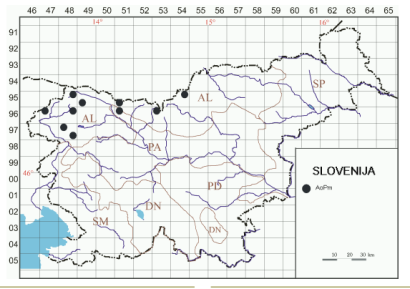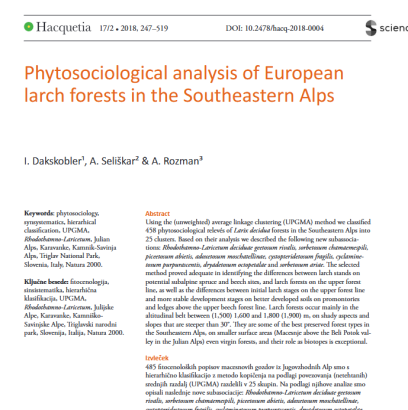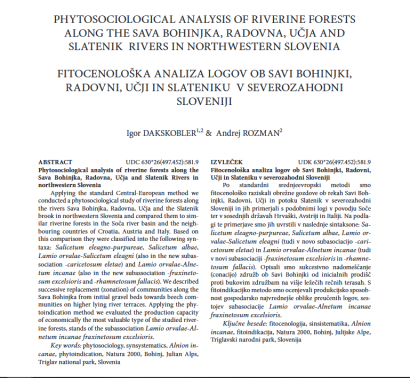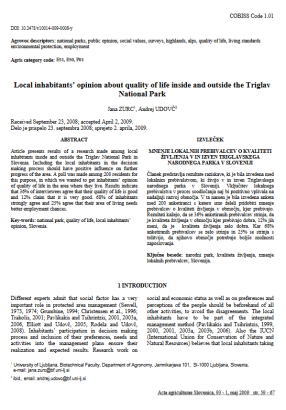Digital library
Showing results 1 - 7/7
Phytosociological description of the dwarf mountain pine shrub community (Amelanchiero ovalis-Pinetum mugo) in the valleys of the Slovenian Alps
We have expanded our knowledge of the localities, sites and distribution of the Amelanchiero ovalis-Pinetum mugo association in the Slovenian Alps. Based on phytocenological analyses, the shrub association belonging to the forest vegetation type Alpine mountain pine scrub was divided into two subassociations: peucedanetosum oreoselini and hylocomiadelphetosum triquetri. We also described four variants within the latter association.
Source
University of Ljubljana, Biotehniška fakulteta
Year
2023
Type
Original scientific article
Format
Document (PDF, DOC, ...)
Authors
Igor Dakskobler, Mateja Cojzer, Andrej Rozman
Keywords
phytosociology, synsystematics, Pinus mugo, Natura 2000, Triglav National Park, Topla Landscape Park, Slovenia
Links
Območja
Triglav National Park, Slovenia
Phytosociological analysis of acidophytic alpine mat-grass swards in the Julian Alps and the Karawanks
Acidophytic alpine mat-grass swards are rare in the alpine belt of the predominantly calcareous Southeastern Alps of Slovenia, mostly occurring where limestone is admixed with marlstone or chert. Those for which we were able to make phytosociological relevés can be classified mainly into two syntaxa: Carici curvulae-Nardetum strictae vaccinietosum gaultherioidis and Sieversio-Nardetum
strictae vaccinietosum. At slightly lower elevations, in the forest zone of the subalpine plateau Pokljuka, we found similar swards occupying small areas in frost hollows with luvisol on limestone. They include character species of various subalpine-alpine sward and snow bed communities and are classified into the syntaxon Homogyno alpinae-Nardetum scorzoneroidetosum croceae.
Source
Digitalna knjižnica Slovenije, ZRC SAZU, Biološki inštitut Jovana Hadžija
Year
2022
Type
Thesis
Format
Website
Authors
Igor Dakskober, Boštjan Surina, Tone Weber
Keywords
Alpine vegetation, Caricion curvulae, Nardion strictae, Mangart, Triglav National Park, Slovenia
Območja
Triglav National Park, Alps, Slovenia
Forests and climate change
Slovenian forests are a national natural treasure that we aim to preserve for future generations. Therefore, the natural disasters that have struck Slovenia's forests over the past decade serve as a serious warning that adaptations in forest stands will be essential. Forestry experts are conducting research that is already providing initial answers to questions about how to assist forests in adapting to inevitable changes in temperature and humidity, strong winds, and extreme weather events.
The broadcast highlights the LIFEGENMON project, in which experts from the Slovenian Forestry Institute monitor the genetic diversity of fir and beech, exploring how to preserve and utilize this diversity for the benefit of the forest. In the future, beech, the queen of Slovenian forests, will increasingly replace the sensitive spruce in areas where harsher conditions due to climate change are certain to arise.
Source
RTV Slovenia (RTV365)
Year
2021
Type
Video clip
Format
Video
Keywords
forest, wood, nature conservation, climate change
Območja
Slovenia
Phytosociological analysis of European larch forests in the Southeastern Alps
Using the (unweighted) average linkage clustering (UPGMA) method we classified 458 phytosociological relevés of Larix decidua forests in the Southeastern Alps into 25 clusters. Based on their analysis we described the following new subassociations: Rhodothamno-Laricetum deciduae geetosum rivalis, sorbetosum chamaemespili, piceetosum abietis, adoxetosum moschatellinae, cystopteridetosum fragilis, cyclaminetosum purpurascentis, dryadetosum octopetalae and sorbetosum ariae. The selected
method proved adequate in identifying the differences between larch stands on potential subalpine spruce and beech sites, and larch forests on the upper forest line, as well as the differences between initial larch stages on the upper forest line
and more stable development stages on better developed soils on promontories and ledges above the upper beech forest line. Larch forests occur mainly in the altitudinal belt between (1,500) 1,600 and 1,800 (1,900) m, on shady aspects and slopes that are steeper than 30°. They are some of the best preserved forest types in the Southeastern Alps, on smaller surface areas (Macesnje above the Beli Potok valley in the Julian Alps) even virgin forests, and their role as biotopes is exceptional.
Source
Digitalna knjižnica Slovenije, ZRC SAZU, Biološki inštitut Jovana Hadžija
Year
2018
Type
Thesis
Format
Website
Authors
Igor Dakskobler, Andrej Seliškar, Andrej Rozman, Andreja Šalamon
Keywords
Phytosociology, synsystematics, hierarhical classification, UPGMA, Rhodothamno-Laricetum, Julian Alps, Karavanke, Kamnik-Savinja Alps, Triglav National Park, Slovenia, Italy, Natura 2000
Območja
Triglav National Park, Alps, Slovenia
Documentary film: Valvasor's Glory
Valvasor’s The Glory of the Duchy of Carniola, first published in the distant year of 1689 and now translated into Slovenian, is an exceptional historical publication highly regarded across all fields of science, from natural sciences to humanities and social sciences. The third book of The Glory is particularly rich in illustrations and content that appeals to a broader audience, making it widely used. A copy of this work, heavily worn and damaged over the centuries, was entrusted for restoration to the Center for the Conservation and Restoration of Written and Graphic Heritage at the Archives of the Republic of Slovenia.
The broadcast, authored by Jadran Sterle and Tugo Štiglic in collaboration with Prof. Dr. Jedert Vodopivec Tomažič from the Archives of the Republic of Slovenia, delves into the fascinating discoveries of the material aspects of The Glory of the Duchy of Carniola, explores the technical background of its creation, and demonstrates how such a priceless book can be restored.
Source
RTV Slovenia (RTV365)
Year
2016
Type
Video clip
Format
Video
Keywords
Janez Vajkard Valvasor, history, The Glory of the Duchy of Carniola
Območja
Slovenia, World
Phytosociological analysis of riverine forests along the Sava Bohinjka, Radovna, Učja and Slatenik Rivers in northwestern Slovenia
Applying the standard Central-European method we conducted a phytosociological study of riverine forests along the rivers Sava Bohinjka, Radovna, Učja and the Slatenik brook in northwestern Slovenia and compared them to similar riverine forests in the Soča river basin and the neighbouring countries of Croatia, Austria and Italy. Based on this comparison they were classified into the following syntaxa: Salicetum eleagno-purpureae, Salicetum albae,
Lamio orvalae-Salicetum eleagni (also in the new subassociation -caricetosum eletae) and Lamio orvalae-Alnetum incanae (also in the new subassociation -fraxinetosum excelsioris and -rhamnetosum fallacis). We described successive replacement (zonation) of communities along the Sava Bohinjka from initial gravel beds towards beech communities on higher lying river terraces. Applying the phytoindication method we evaluated the production capacity
of economically the most valuable type of the studied riverine forests, stands of the subassociation Lamio orvalae-Alnetum incanae fraxinetosum excelsioris.
Source
Digitalna knjižnica Slovenije, Slovenska akademija znanosti in umetnosti
Year
2013
Type
Thesis
Format
Website
Authors
Igor Dakskobler, Andrej Rozman
Keywords
Phytosociology, synsystematics, Alnion incanae, phytoindication, Natura 2000, Bohinj, Julian Alps, Triglav national park, Slovenia
Območja
Triglav National Park, Alps, Slovenia
Local inhabitants' opinion about quality of life inside and outside the Triglav National Park
Article presents results of a research made among local
inhabitants inside and outside the Triglav National Park in
Slovenia. Including the local inhabitants in the decision
making process should have positive influence on further
progress of the area. A poll was made among 200 residents for
this purpose, in which we wanted to get inhabitants’ opinion
of quality of life in the area where they live. Results indicate
that 36% of interviewees agree that their quality of life is good
and 12% claim that it is very good. 68% of inhabitants
strongly agree and 25% agree that their area of living needs
better employment chances.
Source
University of Ljubljana, Biotehniška fakulteta
Year
2009
Type
Original scientific article
Format
Website
Authors
Jana Zurc, Andrej Udovč
Keywords
National park, quality of life, local inhabitants’ opinion, Slovenia
Območja
Triglav National Park, Slovenia







